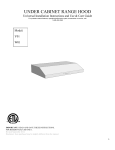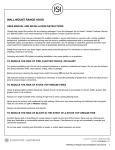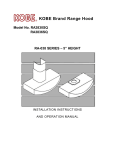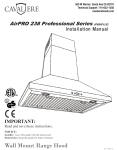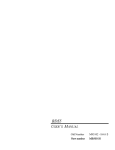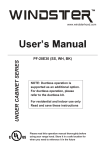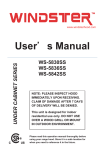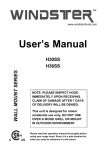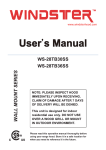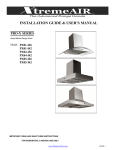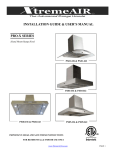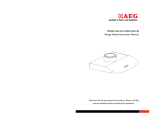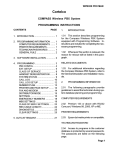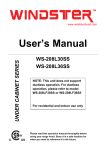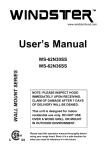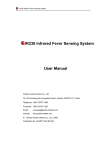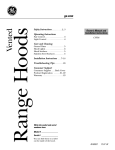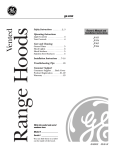Download Manual
Transcript
30" AND 36" UNDER CABINET-MOUNT RANGE HOOD Universal Installation Instructions and Use & Care Guide For questions about features, operation/performance parts, accessories or service, call: 1-626-453-0550 Model: 1801(A) 1802 GV-SR01 IMPORTANT: READ AND SAVE THESE INSTRUCTIONS. FOR RESIDENTIAL USE ONLY. Revised September 2014 Disclaimer: Item purchased may be slightly different from the manual. 1 TABLE OF CONTENTS RANGE HOOD SAFETY ....................................................................3 INSTALLATION REQUIREMENTS ...................................................4 Tools and Parts Requirements ...................................................4 Location Requirements .............................................................4 Installation Dimensions ............................................................5 Ventilation Requirements .........................................................6 Electrical Requirements ............................................................7 INSTALLATION INSTRUCTIONS ..................................................8 Prepare ......................................................................................8 Install Range Hood ...................................................................9 Complete Installation ..............................................................11 RANGE HOOD USE .........................................................................12 Range Hood Controls ..............................................................12 TROUBLE SHOOTING ...................................................................13 RANGE HOOD CARE ......................................................................14 Cleaning ................................................................................. .................................................................................14 Maintenance ...........................................................................15 Replacement ...........................................................................15 WARRENTY & SERVICES .............................................................16 2 RANGE HOOD SAFETY Your safety and the safety of others are very important. We have provided many important safety messages in this manual and on your appliance. Always read and obey all safety messages. This is the safety alert symbol. This symbol alerts you to potential hazards that can kill or hurt you and others. All safety messages will follow the safety alert symbol and either the word “DANGER” or “WARNING.” These words mean: DANGER WARNING You can be killed or seriously injured if you don't immediately follow instructions. You can be killed or seriously injured if you don't follow instructions. IMPORTANT SAFETY INSTRUCTIONS WARNING: TO REDUCE THE RISK OF FIRE, ELECTRIC SHOCK, OR INJURY TO PERSONS, READ THE FOLLOWING: ■ Use this unit only in the manner intended by the manufacturer. If you have questions, please contact the manufacturer. ■ Before servicing or cleaning the unit, switch the power off and lock the service panel. This will prevent the power from accidentally turning on. If the service panel does not lock, secure a warning label, such as a tag, to the service panel. ■ Installation work and electrical wiring must be done by a qualified professional(s) in accordance with all applicable codes, standards, and fire-rated constructions. ■ Do not operate any fans with a damaged cord or plug. Discard the fan or return to an authorized service facility for further examination and/or repair. ■ To prevent back draft, sufficient air is needed for proper combustion. Gas from fuel burning equipment needs to exhaust through the flue (chimney). Follow the heating equipment manufacturer's guideline and safety standards such as those published by the National Fire Protection Association (NFPA), the American Society for Heating, Refrigeration and Air Conditioning Engineers (ASHRAE), and the local code authorities. ■ When cutting or drilling into walls or ceilings; be aware of electrical wires, piping, and other utilities. ■ Ducted fans must always be vented outdoors. CAUTION: For general ventilation use only. Do not use to exhaust hazardous or explosive materials and vapors. CAUTION: To reduce the risk of fire and to properly exhaust air, be sure to duct air outside - DO NOT vent exhaust air into attics, crawl spaces, garages, or within walls and ceilings. WARNING: TO REDUCE THE RISK OF A RANGE TOP GREASE FIRE, READ THE FOLLOWING: ■ Never leave surface units unattended at high settings. Boil-over can cause smoke and grease to spill over that may ignite. Heat oils slowly on low or medium settings. ■ Always turn the hood ON when cooking at high heat or when flambéing food (i.e. Crepes Suzette, Cherries Jubilee, Peppercorn Beef Flambé). ■ Clean ventilation fans frequently. Grease should not be allowed to accumulate on fan or filter. ■ Use proper pan size. Always use cookware appropriate for the size of the surface element. WARNING: TO REDUCE THE RISK OF INJURY. IN THE EVENT OF A RANGE TOP GREASE FIRE, READ THE FOLLOWING: ■ SMOTHER FLAMES with a close fitting lid, cookie sheet, or metal tray, then turn off the burner. BE CAREFUL TO PREVENT BURNS. If the flames do not go out immediately, EVACUATE AND CALL THE FIRE DEPARTMENT. ■ NEVER PICK UP A FLAMING PAN - you may be burned. ■ DO NOT USE WATER, including wet dishcloths or towels a violent steam explosion will result. ■ Use an extinguisher ONLY if: – You know you have a class ABC extinguisher, and you already know how to operate it. – The fire is small and contained in the area where it started. – The fire department is being called. – You can fight the fire with your back to an exit. Based on "Kitchen Fire Safety Tips" published by NFPA. ■ WARNING: To reduce the risk of fire or electrical shock, do not use this fan with any solid-state speed control device. 3 INSTALLATION REQUIREMENT TOOLS AND PARTS REQUIREMENTS Electrical drill or ratchet driver 1/2” drill bit for drilling pilot holes 1 ¼” drill bit for drilling electrical wiring access hole. Screwdrivers: Philips & Straight blade Pliers M5 x 60 QTY:6 Washer QTY:4 Tape measure or ruler and pencil Electrical supplies for wiring Aluminum foils tape and/or duct tape 8 x 50 Wall anchor QTY:6 Hammer M5 x 10 QTY:4 Jigsaw or saber saw Stud finder Parts Supplied Body 1 Pc Chimney mounting bracket 2 Pc Installation manual 1 Set Metal grease filter 2-3 Pcs Hardware 1 Set Disclaimer: Screws many vary from model to model. LOCATION REQUIREMENTS IMPORTANT: Observe all governing codes and ordinances. Have a qualified technician install the range hood. It is the installer’s responsibility to comply with installation clearances specified on the model/serial rating plate. Canopy hood's location should be away from strong draft areas, such as windows, doors, and strong heating vents. Cabinet opening dimensions that are shown must be used. Given dimensions provide minimum clearance. 4 INSTALLATION DIMENSIONS A. B. C. D. Countertop height Hood height from ceiling to bottom of the range hood filter surface: D-A-C=B 27” min. from cooking surface, suggested 30” max. Ceiling height 5 VENTILATION REQUIREMENTS ■ Range hoods must be ventilated to the outdoors, except for non-vented (recirculating) installations. ■ Do not ventilate the range hood into an attic or other enclosed areas. ■ Do not use 4" (10.2 cm) laundry-type wall caps. ■ The length of the range hood and the number of elbows should be kept to a minimum to provide maximum performance. For the most efficient and quiet operation ■ Use no more than three 90° elbows. ■ Make sure there is a minimum of 24" (61 cm) of straight duct between the elbows if more than one elbow is used. ■ Do not install two elbows together. ■ Use clamps to seal all joints in the vent system. ■ The vent system must have a damper. If the roof or wall cap has a damper, do not use the damper supplied with the range hood. ■ Use caulking to seal exterior walls or roof openings around the cap. ■ The size of the vents should be uniform. Venting Method This canopy hood is factory set for through the roof or wall. A 6" (15.2 cm) round vent system is needed for installation. The hood exhaust opening is 6" (15.2 cm) round. To vent through a wall, a 90° elbow is needed. If exhaust ducting with a diameter of less than 5.91” (150 mm) or if flat ducting is used, the noise level of the range hood will increase and extraction will be less efficient. . Cold Weather Installations An additional back draft damper should be installed to minimize backward cold air flow. A thermal break should be installed to minimize conduction of outside temperatures as part of the vent system. The damper should be on the cold air side of the thermal break. The break should be as close as possible to where the vent system enters the heated portion of the house. Makeup Air Local building codes may require the use of makeup air systems, when using ventilation systems greater than specified CFM of air movement. The specified CFM varies from state to state. Consult your HVAC professional for specific requirements in your area. 6 Calculating Vent System Length To calculate the length of the system you need, add the equivalent feet (meters) for all vent pieces used in the system. ELECTRICAL REQIUREMENTS Observe all governing codes and ordinances. Ensure that the electrical installation is adequate and in conformance with the National Electrical Codes, ANSI/NFPA 70 (latest edition), or CSA Standards C22.1-94, Canadian Electrical Code, Part 1 and C22.2 No. 0-M91 (latest edition), all local codes, and ordinances. If codes permit and a separate ground wire is used, it is recommended that a qualified electrician determine that the ground path is adequate. A copy of the above code standards can be obtained from: National Fire Protection Association 1 Batterymarch Park Quincy, MA 02169-7471 CSA International 8501 East Pleasant Valley Road Cleveland, OH 44131-5575 ■ A 120 volt, 60 Hz., AC only, 15-amp, fused electrical circuit is required. ■ If the house has aluminum wiring, follow the procedure below: 1. Connect a section of solid copper wire to the pigtail leads. 2. Connect the aluminum wiring to the copper wire using special connectors and/or tools designed and UL listed for joining copper to aluminum. Follow the manufacturer's recommended procedure for the electrical connector. Aluminum/copper connection must conform to local codes and industry accepted wiring practices. ■ Wire sizes and connections must conform to the rating of the appliance as specified on the model/serial rating plate. The model/serial plate is located behind the filter on the rear wall of the range hood. ■ Wire sizes must conform to the requirements of the National Electrical Code, ANSI/NFPA 70 (latest edition), or CSA Standards C22. 1-94, Canadian Electrical Code, Part 1 and C22.2 No. 0-M91 (latest edition) and all local codes and ordinances. 7 Preparation Advanced Preparations: Be Familiar with the controls of the range hood by reading through Range Hood Controls on Page, 12 Place the range hood on a flat, stable surface. Connect the range hood to a standard outlet and test out all of controls. Place all supplied parts and required hardware on a flat, stable surface and verify all the parts are included. Carefully remove the white plastic protective coat from the range hood. Preparations: NOTE: To avoid damage to your hood, prevent debris from entering the vent opening Decide the location of the venting pipe from the hood to the outside. Refer to Calculating Vent System Length on page 5 A straight, short vent will allow the hood to perform more efficiently. Try to avoid as many transitions, elbows, and long run as possible. This may reduce the performance of the hood. IMPORTANT: Peel white plastic protective coat off the hood, if any. Use silver tape or duct tape to seal joints between the pipe sections. For installing under cabinets with a recessed bottom, attach 4-inch wide wood filler strips (not provided) on each side. Refer to figure 1. Using references in measurements and diagrams on page 5, create an opening for electrical wires and hood exhaust under the cabinet. CAUTION: If moving the cooking range is necessary to install the hood, turn off the power on an electric range at the main electrical box. SHUT OFF THE GAS BEFORE MOVING A GAS RANGE. Puncture the knockout holes (for mounting under the cabinet) on the hood as shown in Figure 2. If necessary, attach two rubber stands with adhesive tapes to the back corners of the hood. 8 Installation Installations: Measure the distance between the stove top and the bottom of the range hood. A distance of 27” to 30” is recommended. 1. There are two ways (A or B) to mount this range hood. 1801A and 1802, Type B does not work. A. Proceed if you would like to mount this range hood without using the hoodmounting bracket. 1. Using references on page 5, center the hood beneath the cabinet and flush with the front of the cabinet. 2. Draw the electrical wires through the cabinet access opening if not done so already. 3. From inside of the hood, place screws into the exact center of each knockout hole and secure to cabinet bottom. Finish tightening all screws until secure. Be careful when using electrical screwdrivers, they may cause damage to the range hood. Skip part B below and proceed to step 2. CAUTION: Make certain the range hood is secure before releasing! B. Proceed if you would like to mount this range hood using the provided hoodmounting bracket (If included). 1. Using references on page 5, mark the leveling point of the hood. Position two mounting screws on the wall, leaving 1/8” space away from the wall. Mounting the hood on wall studs or lumbar’s is high recommended. 2. Attach the hood-mounting bracket to the back of the hood with four screws as show in figure 3. 3. Puncture the knockout wire access hole at the back of the hood and draw the electrical wires. 4. Align hood-mounting brackets to the screws on the wall and hook hood into place as shown in Page 10. Tighten screws to secure hood to the wall. CAUTION: Make certain the range hood is secure before releasing! 2. For safety purpose, pre-drilled mounting holes are provided through the back of the hood. For a more secure installation, use as many mounting holes as needed to secure from the inside of hood. 3. Use 8"(size may vary) venting pipe (follow building codes in your area) to connect the exhaust on the hood to the ductwork above. Use silver tape or duct tape to make all joints secure and air tight. SAFETY WARNING: Risk of electrical shock. This range hood must be properly grounded. Make sure this is done by qualified electrician in accordance with all applicable national and local electrical codes. Before connecting wires, switch power off at service panel and lock service panel to prevent power from being switched on accidentally. 9 Connect the hooks, gaskets and screws to the unit by screwdriver. Figure 3 Screw the anchor screws to suitable location, then hook on, lock screws. 10 Installation Continued 4. Connect the range hood to a designated standard outlet or cut off the plug and connect three wires (black, white and green) to house wires and cap with wire connectors. Connect according to colors ( I.e. black to black, white to white, and green to green. (If applicable) 5. Store excess wires in the wiring box. 6. Drop oil tunnel into recess support near rear of hood. Refer to figure 6. 7. To install baffle filters, refer to Baffle Filters on page 7, for baffle filter placement. Refer to figure 7 for the following five steps: 1. 2. 3. 4. 5. Angle baffle filter toward back of hood. Push baffle filter up until almost level. Slide forward into recess behind the front of the hood. Lower baffle filter. Slide back until it fits into resting positions. 8. Repeat step 7 to install all baffle filters. 9. Turn power ON in control Panel. Check all lights and fan operations. 10. Make sure to leave this installation guide for the homeowner. 11 Control Operation Control Panel Layout and Buttons configurations: A) Lamp: Press the lamp display one time to activate the light, press the lamp display again to deactivate it. B) Timer: When the range hood is on “Standby” Mode, press the timer button for 3 seconds. The range hood will then enter the time setting state; the display screen will show numbers. Press the “+” to set hours and Press the “-“ to set the minutes. After 10 seconds, it will automatically exit the time setting state and the time you have entered will be saved. When the range hood is on, touch the timer button one time. This will turn on the timer mode and the display with show 03:00. Each time you press the timer button, it will increase by 1 minute and the maximum timer setting is 60 minutes. Within the last 3 seconds of the timer setting, the range hood will have three beeps. C) “-“ In standby mode, press this button one time and the range hood will start at F1 speed. If the button is pressed again, the speed will stay the same. D) “+” In standby mode, press this button one time, the range hood will start at F3 speed. If the button is pressed again, the speed will stay the same. E) Speed/Gas/Heater sensor 1. Speed Function – In standby mode, press this button one time, the range hood will start at F3, press this button again and the range hood will turn off. 2. Gas/heater sensor – In standby mode, hold this button for 3 seconds, the range hood will enter automatic gas/heater sensor mode. “AUTO” will flash on the display. That means that the gas/heater sensor is on, the motor and the lamps will turn on automatically if the gas/temperature in the kitchen increases at a rapidly. Hold the button for 3 seconds and the sensor will be turned off. F) Power When the range hood is in the ”original” state, touch this button. It will enter the standby mode. Touch the button again and it will turn off the range hood completely. When the range hood is on, touch this button one time, it will display 60 seconds. The lamp can turn on/off and the speed can be changed in this mode. Press the button again and it will turn off the range hood immediately. 12 Troubleshooting 1. If the range hood or halogen light does not operate after installation: Check if the range hood has been plugged in, make sure that all power has been turned back ON, fused not blown and all electrical wiring are properly connected. Swap out light assembly to working ones to determine whether it is caused by a defective bulb. 2. The range hood vibrates when the blower is on: The range hood might not have been secured properly on the ceiling or wall. 3. The blower or fan seems weak: Check that the duct sized used is at least 8” or 3-1/4 x 10”. Range hood WILL NOT function efficiently with insufficient duct size. For example: 10” duct over 8” hole and loosely secured. Check if duct is clogged or if damper unit (half-circular flapper) is not installed correctly or opening properly. A tight mesh on a side wall cap unit might also cause restriction to the air flow. 4. The lights work but the blower is not spinning at all. It’s stuck or it’s rattling. The blower might be jammed or scraping the bottom due to shipping damage. Please contact us immediately. 5. The hood is not venting out properly. Make sure the distance between the stove top and the bottom of the hood is within 27”-30” in distance. Reduce the number of elbows and length of duct work. Check if all joints are properly connected, sealed, and taped. Make sure the power is on high speed for heavy cooking. NOTE: For all other inquiries, please contact us. 13 Use and care Information Operation: Read and understand all instructions and warnings in this manual before operating the appliance. Save these instructions for future reference. Always leave safety grills and filters in place. Without these components. Operating blowers could catch on to hair, fingers and loose clothing. NEVER dispose cigarette ashes, ignitable substances, or any foreign objects into blowers. NEVER leave cooking unattended. When frying, oil in the pan, it can easily overheat and catch fire. The risk of self combustion is higher when the oil has been used several times. NEVER cook on “open” flames under the range hood. Check deep-fryers during use. Superheated oil may be flammable. Cleaning: The saturation of greasy residue in the blower and filters may cause increased inflammability. Keep unit clean and free of grease and residue build-up at all times to prevent possible fires. Filters must be cleaned periodically and free from accumulation of cooking residue. Old and worn filters must be replaced immediately. DO NOT operate blowers when filters are removed. Never disassemble parts to clean without proper instructions. Disassembly is recommended to be performed by qualified personnel only. Read and understand all instructions and warnings in this manual before proceeding. 14 Maintenance Safety warning: Never put your hand into area housing the fan while the fan is operating! For optimal operation, clean range hood and all baffle/spacer/filter/grease tunnel/oil container regularly. Regular care will help preserve the appearance of the range hood. Cleaning Exterior surfaces: Clean periodically with hot soapy water and clean cotton cloth. Do not use corrosive or abrasive detergent, or steel wool/scoring pads, which will scratch and damage the stainless steels surface. For heavier soil use liquid degreaser. If hood looks splotchy, use a stainless steel cleaner to clean the surface of the hood. Avoid getting clean solution onto or into the control panel. Follow directions of the stainless steel cleaner. CAUTION: DO NOT leave on too long, as this may cause damage to the hoods finish. Use a soft towel to wipe off the cleaning solutions. Gently rub off any stubborn spots, Use dry soft towel to dry the hood. After cleaning, you may use non abrasive stainless steel polish to polish and buff out the stainless luster and grain. Always scrub lightly, with clean cotton cloth, and with the grain. DO NOT allow deposits to accumulate or remain on the hood. DO NOT use ordinary steel wool or steel brushes. Small bits of steel may adhere to the surface and cause rusting. DO NOT allow salt solutions, disinfectants, bleaches, or cleaning compounds to remain in contact with water after exposure and wipe dry with a clean cloth. Replacing Filters: Should filters wear out due to age and prolonged use, please contact us for replacement filters. Note: Also replace damaged filters that has punctured or broken mesh. Replacing the light bulb: Make sure the range hood is unplugged or turn OFF the breaker. Make sure the lights are cool to touch, carefully align the arrow on the inner ring with the arrow on the outer ring where it says OIPEN. The inner ring will loosen the light and will be available for removal. To install the new lights, reverse the steps. Turn ON the breaker and range hood to test for operation. 15 SHOPRANGEHOODS.COM MAJOR APPLIANCE WARRANTY LIMITED WARRANTY For three year from the date of purchase, when this major appliance is operated and maintained according to instructions attached to or furnished with the product, Www.shoprangehoods.com will pay for Factory Specified Parts. This limited warranty is valid only in the United States or Canada and applies only when the major appliance is used in the country in which it was purchased. Outside the 50 United States and Canada, this limited warranty does not apply. Proof of original purchase date is required to obtain service under this limited warranty. ITEMS EXCLUDED FROM WARRANTY This limited warranty does not cover: 1. Service calls to correct the installation of your major appliance, to instruct you on how to use your major appliance, to replace or repair house fuses, or to correct house wiring or plumbing. 2. Service calls to repair or replace appliance light bulbs, air filters or water filters. Consumable parts are excluded from warranty coverage. 3. Repairs when your major appliance is used for other than normal, single-family household use or when it is used in a manner that is contrary to published user or operator instructions and/or installation instructions. 4. Damage resulting from accident, alteration, misuse, abuse, fire, flood, acts of God, improper installation, installation not in accordance with electrical or plumbing codes, or use of consumables or cleaning products not approved by Www.shoprangehoods.com. 5. Cosmetic damage, including scratches, dents, chips or other damage to the finish of your major appliance, unless such damage results from defects in materials or workmanship and is reported to Www.shoprangehoods.com within 30 days from the date of purchase. 6. Any food loss due to refrigerator or freezer product failures. 7. Costs associated with the removal from your home of your major appliance for repairs. This major appliance is designed to be repaired in the home and only in-home service is covered by this warranty. 8. Repairs to parts or systems resulting from unauthorized modifications made to the appliance. 9. The removal and reinstallation of your major appliance if it is installed in an inaccessible location or is not installed in accordance with published installation instructions. 10. Major appliances with original model/serial numbers that have been removed, altered or cannot be easily determined. This warranty is void if the factory applied serial number has been altered or removed from your major appliance. The cost of repair or replacement under these excluded circumstances shall be borne by the customer. DISCLAIMER OF IMPLIED WARRANTIES; LIMITATION OF REMEDIES CUSTOMER'S SOLE AND EXCLUSIVE REMEDY UNDER THIS LIMITED WARRANTY SHALL BE PRODUCT REPAIR AS PROVIDED HEREIN. IMPLIED WARRANTIES, INCLUDING WARRANTIES OF MERCHANTABILITY OR FITNESS FOR A PARTICULAR PURPOSE, ARE LIMITED TO ONE YEAR OR THE SHORTEST PERIOD ALLOWED BY LAW. WWW.SHOPRANGEHOODS.COM SHALL NOT BE LIABLE FOR INCIDENTAL OR CONSEQUENTIAL DAMAGES. SOME STATES AND PROVINCES DO NOT ALLOW THE EXCLU-SION OR LIMITATION OF INCIDENTAL OR CONSEQUENTIAL DAMAGES, OR LIMITATIONS ON THE DURATION OF IMPLIED WARRANTIES OF MERCHANTABILITY OR FITNESS, SO THESE EXCLU-SIONS OR LIMITATIONS MAY NOT APPLY TO YOU. THIS WARRANTY GIVES YOU SPECIFIC LEGAL RIGHTS, AND YOU MAY ALSO HAVE OTHER RIGHTS WHICH VARY FROM STATE TO STATE OR PROVINCE TO PROVINCE. If you need service, first see the “Troubleshooting” section of the User Manual. After checking “Troubleshooting,” you may find additional help by calling Www.shoprangehoods.com. In the U.S.A., call 1626-453-0550 or visit our website at www.ShopRangeHoods.com .Keep this book and your sales slip together for future reference. You must provide proof of purchase or installation date for in-warranty service. Write down the following information about your major appliance to better help you obtain assistance or service if you ever need it. You will need to know your complete model number and serial number. You can find this information on the model and serial number label located on the product. Dealer name____________________________________________________ Address _______________________________________________________ Phone number__________________________________________________ Model number __________________________________________________ Serial number __________________________________________________ Purchase date __________________________________________________ 16
















